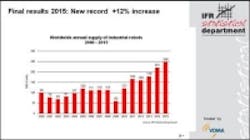Global sales of industrial robots reach record number in 2015
Worldwide sales ofindustrial robots reached 248,000 units in 2015, a figure that represents a 12% rise year over year and a new record number, according to figures released by the International Federation of Robotics (IFR).
A global rise in robotics can be attributed to a number of factors, including emerging countries utilizingautomation technologies, as well as increased figures in regions that had already been using such technologies. In Europe, for example, total sales figures for industrial robots in 2015 rose by 10% to 50,000 units, with the three strongest individual markets being Germany (20,000 units), Italy (6,700 units) and Spain (3,800 units).
Growth in North America was also significant, with sales increasing by 15% to a total of 37,000 units. The United States tops the list with 27,000 units sold (3% increase), but a huge leap was registered in Mexico, with sales more than doubling within one year to around 5,500 units. This was accomplished, according to the IFR, because of significant investments made in the automotive industry, the products of which Mexico exports to the USA and South America.
In Asia, the world’s strongest growth market at this time, a total of 156,000 units were sold in 2015, which is a 16% increase over 2014. With 68,000 industrial robots sold, China—which saw a 17% increase—surpassed the total market volume for Europe. Elsewhere in Asia, South Korea saw 37,000 units sold, while Japan had 35,000 units sold. The top five countries overall, China, South Korea, Japan, USA, and Germany, account for three-quarters of the global sales of industrial robots.
By sector, the automotive industry had some 95,000 units sold into the segment, a 1% rise, while other sectors also saw growth in 2015: the metal industry (63% increase), the plastics and rubber industry 40% increase), and the electronics industry (16% increase).
"The wave of digital transformation and automation will continue to drive the robotics boom forward until 2018," says Joe Gemma, President of the International Federation of Robotics. "Revolutionary developments in IT connected with all aspects of the Internet of Things, and new networked services are changing the producing industries fundamentally. Machines, logistics and production plants are merging into integrated cyber-physical systems. The aim is to use smart factories to work more flexibly, more cost-efficiently and more productively."
View theIFR press release
Share your vision-related news by contactingJames Carroll, Senior Web Editor, Vision Systems Design
To receive news like this in your inbox, click here.
Join ourLinkedIn group | Like us on Facebook | Follow us on Twitter
About the Author

James Carroll
Former VSD Editor James Carroll joined the team 2013. Carroll covered machine vision and imaging from numerous angles, including application stories, industry news, market updates, and new products. In addition to writing and editing articles, Carroll managed the Innovators Awards program and webcasts.
